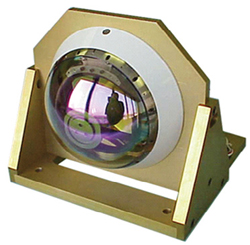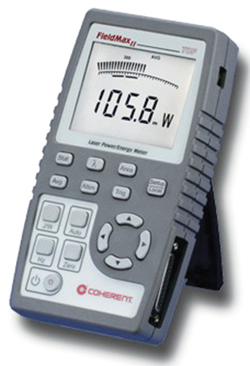They also offer temperature controllers to stabilise the output wavelength. Temperature controllers for diode laser temperature control are also available in a wide range of performance parameters to suit different requirement specifications. Both benchtop units and OEM modules are commercially available. Fig. 4 shows the photograph of a typical benchtop thermoelectric laser diode temperature controller. Most of these temperature controllers are capable of operating in constant temperature, constant power or constant current modes with temperature stability of better than 0.003°C.
Gas laser electronics
He-Ne and carbon dioxide lasers are the most commonly used gas laser sources. While carbon dioxide lasers are commonly used in some types of laser rangefinders, He-Ne lasers mainly find application in inertial navigation sensor. What most of us know about the He-Ne laser electronics is a high-voltage power supply that initiates and subsequently sustains the plasma. The plasma current stabilisation may not be important if it is to be used for the purpose of alignment. But when it comes to using the same laser in an inertial-grade rotation rate sensor such as a ring laser gyroscope (Fig. 5), the current would need to be stabilised to a level better than 100 ppm.
In addition, you would also need to stabilise its frequency to better than +1MHz on its Doppler broadened gain curve which is about 1400MHz wide for 632.8nm output wavelength. To further add to the design complexity of plasma current initiation and control circuit, the difference between the plasma currents in the two counter propagating laser beams needs to be stabilised to an order of magnitude better current stability than the absolute current stability of each arm.
Frequency stabilisation of gas lasers is a complete field in itself. There are scientists who have worked in this area for decades to discover new methods to stabilise the laser frequency using active means or improve upon those already existing. Different frequency stabilisation techniques include dither stabilisation, optogalvanic stabilisation and Stark-cell stabilisation. It is possible to actively stabilise the frequency of carbon dioxide lasers to better than a few kilohertz using Stark-cell stabilisation by stabilising the frequency to the centre of lamb dip on the gain versus frequency curve.
In the category of carbon dioxide lasers, we have both DC-excited as well as RF-excited lasers. While the design of power supply for a DC-excited carbon dioxide laser is similar in concept to the one used in the case of He-Ne lasers except of current and voltage levels. in the case of RF-excited lasers, typical excitation source comprises an RF source operating in the frequency range of 50-150MHz and an impedance matching network. The RF source may further be split up into an RF oscillator and a cascade arrangement of RF amplifiers depending upon the output power delivering capability. RF power is fed to the laser cavity through impedance matching network.
Laser sensors
In a large number of opto-electronic systems, in particular the battlefield opto-electronic systems, the primary function is detection of laser radiation with or without its important parameters depending upon the intended application. Some such systems include laser warning sensors, laser position sensors and laser seekers. Laser warning sensor system is an essential constituent of both passive and active EOCM systems.
In the simplest form, a laser warning sensor may be used to detect the existence of a laser threat without giving any information on the direction of arrival of the threat.



In another case, it may also have the direction-sensing feature with the resolution of direction sensing varying with the intended application from a coarse-sensing capability in the range of ±5° to ±45° to high-resolution sensing with direction-of-arrival sensing capability in the range of ±0.1° to ±1.0°.
In addition, the operational wavelength band may also vary from one application to another. More complex laser warning systems indicate the type of laser threat, the wavelength and the direction of arrival of the threat. A typical high-end laser warning sensor is capable of characterising threats from laser rangefinders, laser target designators and laser beam riders, and these are available for mounting on helicopters, main battle tanks and light-armoured vehicles.
While one of the most common military applications of a laser warning sensor is as a sub-system in an integrated EOCM system for armoured fighting platforms, there are many other application scenarios where laser sensors are deployed.










